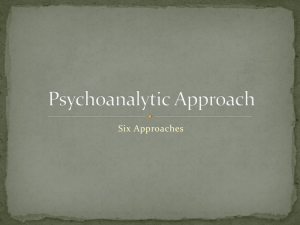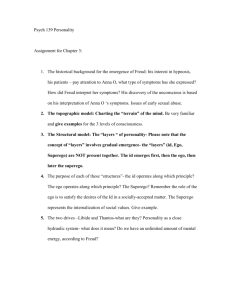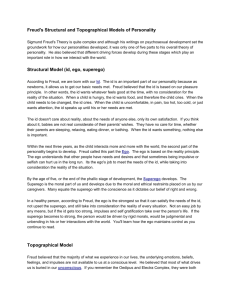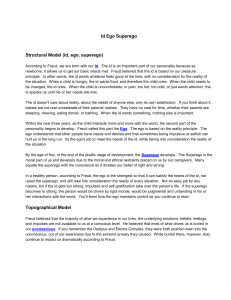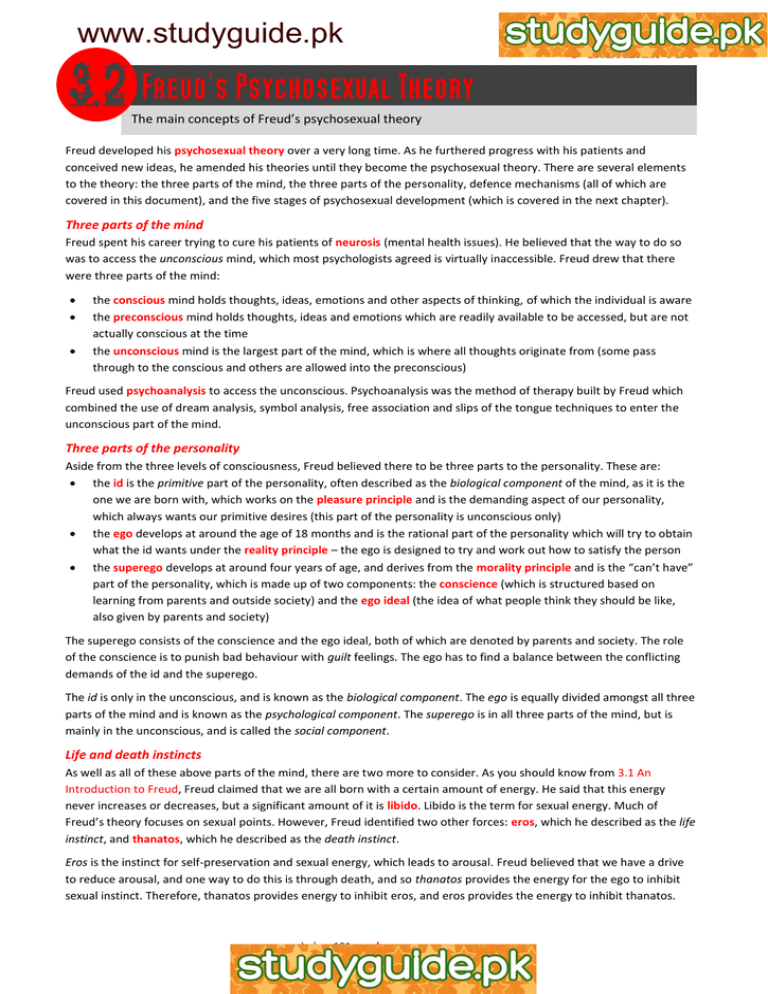
www.studyguide.pk
The main concepts of Freud’s psychosexual theory
Freud developed his psychosexual theory over a very long time. As he furthered progress with his patients and
conceived new ideas, he amended his theories until they become the psychosexual theory. There are several elements
to the theory: the three parts of the mind, the three parts of the personality, defence mechanisms (all of which are
covered in this document), and the five stages of psychosexual development (which is covered in the next chapter).
Three parts of the mind
Freud spent his career trying to cure his patients of neurosis (mental health issues). He believed that the way to do so
was to access the unconscious mind, which most psychologists agreed is virtually inaccessible. Freud drew that there
were three parts of the mind:
the conscious mind holds thoughts, ideas, emotions and other aspects of thinking, of which the individual is aware
the preconscious mind holds thoughts, ideas and emotions which are readily available to be accessed, but are not
actually conscious at the time
the unconscious mind is the largest part of the mind, which is where all thoughts originate from (some pass
through to the conscious and others are allowed into the preconscious)
Freud used psychoanalysis to access the unconscious. Psychoanalysis was the method of therapy built by Freud which
combined the use of dream analysis, symbol analysis, free association and slips of the tongue techniques to enter the
unconscious part of the mind.
Three parts of the personality
Aside from the three levels of consciousness, Freud believed there to be three parts to the personality. These are:
the id is the primitive part of the personality, often described as the biological component of the mind, as it is the
one we are born with, which works on the pleasure principle and is the demanding aspect of our personality,
which always wants our primitive desires (this part of the personality is unconscious only)
the ego develops at around the age of 18 months and is the rational part of the personality which will try to obtain
what the id wants under the reality principle – the ego is designed to try and work out how to satisfy the person
the superego develops at around four years of age, and derives from the morality principle and is the “can’t have”
part of the personality, which is made up of two components: the conscience (which is structured based on
learning from parents and outside society) and the ego ideal (the idea of what people think they should be like,
also given by parents and society)
The superego consists of the conscience and the ego ideal, both of which are denoted by parents and society. The role
of the conscience is to punish bad behaviour with guilt feelings. The ego has to find a balance between the conflicting
demands of the id and the superego.
The id is only in the unconscious, and is known as the biological component. The ego is equally divided amongst all three
parts of the mind and is known as the psychological component. The superego is in all three parts of the mind, but is
mainly in the unconscious, and is called the social component.
Life and death instincts
As well as all of these above parts of the mind, there are two more to consider. As you should know from 3.1 An
Introduction to Freud, Freud claimed that we are all born with a certain amount of energy. He said that this energy
never increases or decreases, but a significant amount of it is libido. Libido is the term for sexual energy. Much of
Freud’s theory focuses on sexual points. However, Freud identified two other forces: eros, which he described as the life
instinct, and thanatos, which he described as the death instinct.
Eros is the instinct for self-preservation and sexual energy, which leads to arousal. Freud believed that we have a drive
to reduce arousal, and one way to do this is through death, and so thanatos provides the energy for the ego to inhibit
sexual instinct. Therefore, thanatos provides energy to inhibit eros, and eros provides the energy to inhibit thanatos.
www.aspsychology101.wordpress.com
www.studyguide.pk
All of these features can be easily displayed on a simple diagram. It is common to see the iceberg analogy which shows
an iceberg (which represents the mind) floating in the water. The diagram below shows the three levels of
consciousness and how the parts of the personality are divided between them.
The conscious is where contact
with the outside world is made
EGO
(psychological
component)
CONSCIOUS MIND
PRECONSCIOUS MIND
UNCONSCIOUS MIND
REALITY PRINCIPLE
SUPEREGO
(social
component)
MORALITY
PRINCIPLE
contains the
conscience
and the ego
ideal
ID
(biological component)
eros and thanatos are
associated with the id and
the unconscious mind
PLEASURE PRINCIPLE
All energy originates
from the unconscious
Mentioned above was the
fact that the ego has the
job of trying to balance
the id and the superego.
It may also have to
balance any conflicting
demands in the id. One
way in which it does this
can be through the use of
defence mechanisms.
These are designed to
push thoughts, feelings
and desires out of the
conscious mind, or can
transfer a desire onto
something safer.
For your course, you must
learn about repression as
one defence mechanism
as well as one other
mechanism of your
choosing.
Defence mechanisms
The one defence mechanism you must learn about is repression. Repression involves keeping thoughts in the
unconscious mind so that they are not remembered, as they are not allowed inside the conscious. It is as if they are
forgotten, or at least not remembered – so it is sometimes known as motivated forgetting. However, this cannot be
done consciously, it is done subconsciously. The table below displays the five defence mechanisms covered in this
course, their explanations and an example of when each one would be used. Remember you need to know about
repression as well as one other one of your choice:
Explanation
Example
involves keeping thoughts in the unconscious, and not
allowing them into the conscious, so that they are not
remembered (called “motivated forgetting”), a
process which is not done consciously
childhood sexual abuse – often adults
will not be able to remember their
abuse; they will not deny it happening,
but cannot remember the abuse
Denial
found when someone denies a traumatic event has
occurred and acts as though nothing has happened,
protecting the individual from unhappy or
unacceptable thoughts
denial of feelings – often if somebody
has inappropriate sexual feelings for
another person, they will deny having
such feelings
Projection
when somebody deals with having unacceptable
thoughts by saying that they are somebody else’s
thoughts, perhaps so that the ego can deal with the
feelings without problems from the superego
envy – sometimes people who envy
someone will actually claim that that
person envies them
Repression
www.aspsychology101.wordpress.com
www.studyguide.pk
Explanation
Displacement
Denial
Example
this occurs when thoughts or wishes that an individual
finds to be unacceptable are transferred onto
someone or something else, or the urges/thoughts are
turned into something different
using the comforting behaviours of an earlier age to
cope with something which is currently causing a
significant amount of stress
sport – anger might be turned into
physical aggression in sport
aggression – shouting at your wife as
you get home because you’re angry with
your boss but don’t want to shout at him
examples include crying, thumb-sucking
and refusing to accept responsibility
There are various strengths and weaknesses for the idea of defence mechanisms. It was actually Freud’s daughter, Anna
Freud who first talked about defence mechanisms. She was the sixth (and last) child of Sigmund Freud’s, and she
followed in his footsteps in establishing the at-that-time new form of therapy, psychoanalysis. The table below
summarises just a couple of the strengths and weaknesses:
There are everyday examples of all of the above
defence mechanisms in real life (anecdotal
examples), such as crime victims often experiencing
repression, and denial being frequently found in
everyday language
When a defence mechanism is revealed to someone
and they have it explained to them how defence
mechanisms work, they tend to feel a bit better (this
is because Freud claimed that the mechanisms keep
the primitive urges of the id in the unconscious, but
once revealed to the conscious, the problems stop)
The concept of defence mechanisms cannot be tested
scientifically, as the DV is not operationalised (whilst
we do find everyday, real-life examples of them in
action – this is not scientific testing)
Because defence mechanisms are specific to an
individual, they require the interpretation of the
analyst (such as with projection, for example, whilst
one person might claim that somebody else is jealous
of them, and that’s because they are in fact jealous of
that person, for another person, it may actually just
be that the other person is envious of them)
www.aspsychology101.wordpress.com



